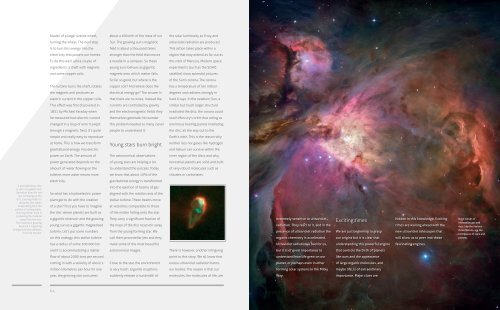Sol Lucet Omnibus - ESO
Sol Lucet Omnibus - ESO
Sol Lucet Omnibus - ESO
- TAGS
- lucet
- omnibus
- www.eso.org
You also want an ePaper? Increase the reach of your titles
YUMPU automatically turns print PDFs into web optimized ePapers that Google loves.
A protoplanetary disc<br />
is seen as a green oval.<br />
Radiation from the hot<br />
star is heating up the<br />
disc, causing matter to<br />
dissipate, like steam<br />
evaporating from the<br />
surface of boiling water.<br />
A strong stellar wind is<br />
propelling the material<br />
away from the disc.<br />
The material is glowing<br />
because it is gaining<br />
energy from the radiation<br />
from the hot star.<br />
blades of a large turbine wheel,<br />
turning the wheel. The next step<br />
is to turn this energy into the<br />
electricity that powers our homes.<br />
To do this we’ll add a couple of<br />
ingredients: a shaft with magnets<br />
and some copper coils.<br />
The turbine turns the shaft, rotates<br />
the magnets and produces an<br />
electric current in the copper coils.<br />
This effect was first discovered in<br />
1831 by Michael Faraday when<br />
he measured how electric current<br />
changed in a loop of wire it swept<br />
through a magnetic field. It’s quite<br />
simple and really easy to reproduce<br />
at home. This is how we transform<br />
gravitational energy into electric<br />
power on Earth. The amount of<br />
power generated depends on the<br />
amount of water flowing on the<br />
turbine; more water means more<br />
electricity.<br />
So what has a hydroelectric power<br />
plant got to do with the creation<br />
of a star? First you have to imagine<br />
the disc where planets are built as<br />
a gigantic reservoir and the growing<br />
young sun as a gigantic magnetised<br />
turbine. Let’s put some numbers<br />
on this analogy: this stellar turbine<br />
has a radius of some 100 000 km<br />
and it is accommodating a matter<br />
flow of about 2000 tons per second<br />
coming in with a velocity of about 1<br />
million kilometres per hour! In one<br />
year, the growing star consumes<br />
64<br />
about a billionth of the mass of our<br />
Sun. The growing sun’s magnetic<br />
field is about a thousand times<br />
stronger than the field that moves<br />
a needle in a compass. So these<br />
young suns behave as gigantic<br />
magnets onto which matter falls.<br />
So far so good, but where is the<br />
copper coil? And where does the<br />
electrical energy go? The answer is<br />
that there are no wires, instead the<br />
currents are controlled by gravity<br />
and the electromagnetic fields they<br />
themselves generate. No wonder<br />
this problem needed so many clever<br />
people to understand it.<br />
Young stars burn bright<br />
The astronomical observations<br />
of young stars are helping a lot<br />
to understand the process. Today<br />
we know that about 10% of the<br />
gravitational energy is transformed<br />
into the ejection of beams of gas<br />
aligned with the rotation axis of the<br />
stellar turbine. These beams move<br />
at velocities comparable to those<br />
of the matter falling onto the star.<br />
They carry a significant fraction of<br />
the mass of the disc reservoir away<br />
from the young forming star. We<br />
call them protostellar jets and they<br />
make some of the most beautiful<br />
astronomical images.<br />
Close to the star, the environment<br />
is very harsh. Gigantic eruptions<br />
suddenly release a hundredth of<br />
the solar luminosity as X-ray and<br />
ultraviolet radiation are produced.<br />
This action takes place within a<br />
region that may extend as far out as<br />
the orbit of Mercury. Modern space<br />
experiments (such as the SOHO<br />
satellite) show splendid pictures<br />
of the Sun’s corona. The corona<br />
has a temperature of ten million<br />
degrees and radiates strongly in<br />
hard X-rays. In the newborn Sun, a<br />
similar but much larger structure<br />
irradiated the disc; the corona could<br />
reach Mercury’s orbit thus acting as<br />
enormous heating panels irradiating<br />
the disc, all the way out to the<br />
Earth’s orbit. This is the reason why<br />
neither ices nor gases like hydrogen<br />
and helium can survive within the<br />
inner region of the discs and why<br />
terrestrial planets are solid and built<br />
of very robust molecules such as<br />
silicates or carbonates.<br />
There is however, another intriguing<br />
point to this story. We all know that<br />
excess ultraviolet radiation harms<br />
our bodies. The reason is that our<br />
molecules, the molecules of life, are<br />
extremely sensitive to ultraviolet<br />
radiation. They react to it, and in the<br />
presence of ultraviolet radiation the<br />
organic chemistry is accelerated.<br />
Ultraviolet radiation is bad for us,<br />
but it is of great importance to<br />
understand how life grew on our<br />
planet, or perhaps even in other<br />
forming solar systems in the Milky<br />
Way.<br />
Exciting times<br />
We are just beginning to grasp<br />
our origins but it is clear that<br />
understanding this powerful engine<br />
that controls the birth of planets<br />
like ours and the appearance<br />
of large organic molecules, and<br />
maybe life, is of extraordinary<br />
importance. Major clues are<br />
hidden in this knowledge. Exciting<br />
times are waiting ahead with the<br />
new ultraviolet telescopes that<br />
will allow us to peer into these<br />
fascinating engines.<br />
65<br />
Huge clouds of<br />
interstellar gas and<br />
dust, like the famous<br />
Orion Nebula, are the<br />
birthplaces of stars and<br />
planets.

















